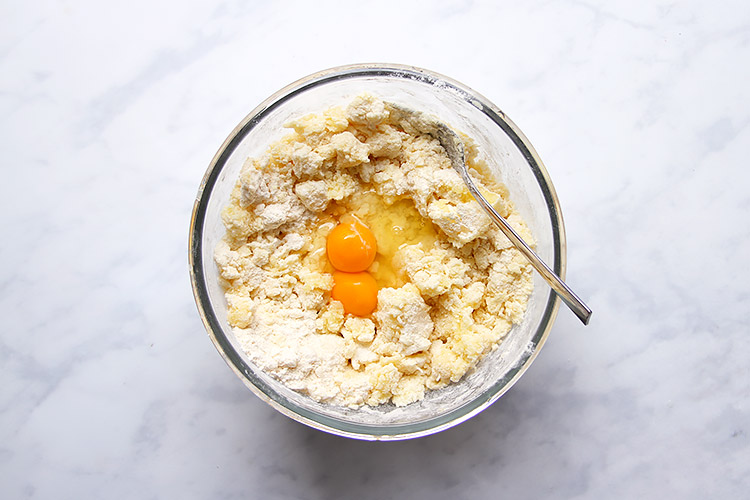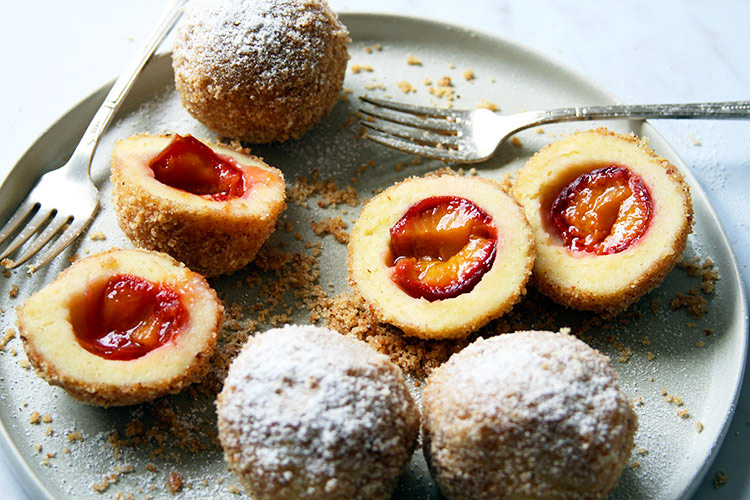
Traditional Austrian plum dumplings, known as Zwetschkenknödel, are great as a dessert, or a sweet and meatless main course. I love to eat them for lunch!
Plum dumplings are common throughout Central and Eastern Europe. Being Austrian, I grew up eating plum dumplings every late summer and fall.
These dumplings are made by stuffing damsons or small plums into a potato-based dough. Then they are simmered in water and covered in sweet, buttery, and nutty breadcrumbs. Cutting the dumplings open and making the plum burst open will give you a weird satisfaction :-)

Potato dough for plum dumplings
I make the dough with freshly riced or grated potatoes, which gives the dumplings a wonderful subtle potato taste that pairs well with hot plums. The dough is pretty similar to gnocchi dough, which is why you can use leftover dough to make gnocchi. I always prepare enough dough to make plum dumplings AND gnocchi :)
If you prefer plum dumplings with curd cheese dough, try this recipe.
Which plums for dumplings?

The small oval damson plums are preferable, but Italian prune plums, which are similar, will work fine. Usually, the pit removes easily with damsons, which makes things fuss-free. In general: The smaller the plums, the better since larger fruits may not cook through and will not soften properly in the short cooking time.
By the way, you can use any (small) stone fruit to fill this dumplings. Apricots, for example, are super delicious.
Step by step recipe for plum dumplings

Grate potatoes and let cool. I use the small holes from a box grater.
First, you have to make the potato dough. Boil the potatoes until fork tender, about 20 minutes. When cool enough to handle, peel them and process through a ricer.
If you don’t have a ricer, grate them using the small holes of a box grater. Make sure there are no potato chunks left since they make forming the dough difficult. Let the riced/grated potatoes cool.

Add the egg and incorporate with a fork. Here I doubled the recipe, hence 2 eggs.
Put grated potatoes in a large bowl. Sprinkle with salt and butter, then add flour and semolina. Stir until most of the flour is worked in. Add the egg and incorporate with a fork.

Briefly knead until a dough forms.
Briefly knead the dough until the ingredients stick together and form a dough (do not overwork it). The dough will be rather sticky.

Flatten the dough into rounds, put a plum in the center and seal it.
Wash the plums. Cut each plum lengthwise, but not all the way through, just enough to be able to pit them. Remove pits. If you have a sweet tooth, you can fill them with half a teaspoon of sugar (I never do). Alternatively, you can leave the plums whole with the pit inside – this way it is easier to wrap the dough around.
Divide the dough into 9 portions on a well-floured surface. Tip: If your plums are rather large, divide dough into 8 portions. If you like dumplings with a thin dough layer, divide into 12 portions but be aware that they are more difficult to wrap with thin dough.
Flatten each portion to a round with well-floured hands and place a plum in the center. Tightly wrap the dough around the plum, sealing the edges and shaping it into a ball. If the edge isn’t sticking since you used too much flour, dip your finger in water and wet the edge to close the dough around the plum.

The shaped dumplings should look like this.
Make sure you don’t trap any air inside or the dumpling will not sink to the bottom of the pot as it is supposed to but will float from the beginning. No worries if it happens anyways, but it’s better if they are sinking down since the dough is cooked properly and the chance of bursting is lower.

Coat the dumplings in a buttery mixture of bread crumbs, ground hazelnuts, sugar, and cinnamon.
In a large pot, bring salted water to a boil. Cook the plum dumplings for about 12-15 minutes in slightly simmering water (no rolling boil) – they should float towards the end of the cooking time. Make sure that they do not stick to the bottom of the pot.
In the meantime, make the breadcrumbs. In a large pan, melt the butter, add the breadcrumbs and ground nuts. Stir well for a few minutes over medium heat until the breadcrumbs and nuts are slightly darker and smell nicely. Stir in sugar and cinnamon. Remove pan from the heat and keep an eye on the buttered breadcrumbs because the residual heat can burn them easily (stir regularly).
Remove the dumplings with a slotted spoon and transfer them to the pan with the breadcrumbs. Roll the dumplings in the crumbs until coated.

Dust the dumplings with confectioners’ sugar and serve immediately. Enjoy!
If you have leftovers, store the dumplings in an airtight container in the fridge. They will keep for up to 3 days.

If you prefer apricots and a dough without potatos (but farmer’s cheese), find the recipe here.
Have you tried apricot dumplings yet? Here is a delicious recipe for apricot dumplings with curd cheese dough.
Have fun making dumplings!
For these traditional Austrian plum dumplings, plums are wrapped in a potato dough and covered in sweet buttery and nutty bread crumbs. They can be eaten as a dessert, or a sweet main course. I love to eat them for lunch! Depending on the size of the plums and the thickness of the dough surrounding the plum, this recipe will make 8 to 12 dumplings. Instead of plums, you can use other (small) stone fruit, like apricots, too. If you prefer curd cheese dough over potato dough, you can use this recipe. Recipe: Ursula | lilvienna.com Ingredients Instructions Notes Plums:
Use small oval damson plums or Italian prune plums. Usually, the pit removes easily with damsons, which makes things fuss-free. In general: The smaller the plums, the better since larger fruits may not cook through and will not soften properly in the short cooking time.
Freezing instructions:
Pre-freeze the formed and uncooked dumplings on a baking sheet or cutting board lined with parchment paper. Leave some space in between the dumplings so they won't stick together later. Transfer the pre-frozen dumplings to a freezer bag (I always put 2 pieces in one bag for a single serving). For cooking, simply add the dumplings to boiling salted water, then simmer until cooked, see recipe above. The cooking time will be slightly longer.





Dear Lilvienna,
I am new to your website but it wil” be my favorite from now on. The plum dumplings I will write down the recipe because it onda me of my childhood. My mother used to make it. Lil, I need your help with something. I would like to make elderberry syrup but I can find only dry flowers. Is it possible to make the syrup with dry flowers? The, my mother used to make creamschnit. I am not sure I spell it right. Do you have a recipe for cremschnit? Thank you so much for taking the time to reply to me.
Elisabeta
Hi Elisabeta,
Happy that you found the blog! Plum dumplings are my favorite :)
As for the elderflower syrup: I have never made the syrup using dried elerflowers, but if you jump to the recipe, you can find a comment below the recipe from Kimberly (October 8, 2019) – she made the syrup with dried elderflowers. She said that the color of the syrup is a bit darker but still the taste is wonderful. But as I’ve said, I have never tried using dried elderflowers so I can’t garantee that this works fine.
Oh, and I think you mean Cremeschnitte. Unfortunately, I don’t have a recipe on the blog yet, but there are a lot out there, simply google “cremeschnitte recipe”. I’m sure you’ll find something similar to your mother’s.
Ursula
I so want to recreate my mother’s plum dumplings, with, I thought a strong Hungarian and German background.
However, after the prunes and dough were cooked, my mother used farina and butter, browned, to coat the dumplings. I can’t find this anywhere on line. It was divine, as was everything my mother cooked. Of course, there was never a recipe…
If you have any ideas as to where to look, would be so appreciative.
Thank you for your guidance.
Sincerely,
Fran Mullen
Hi Fran,
Interesting! I have never heard of using farina + butter to coat the dumplings. In Austria, we either use dry breadcrumbs + butter + sugar or add ground nuts. So what you are saying is new to me too. Sorry that I can’t help you with this and I hope you’ll find a recipe like the one you described here.
Ursula
My Yugoslav grandmother would not add anything to the buttered bread crumbs, instead we would cut the dumplings open and sprinkle with sugar and cinnamon.
I found freezing the plums beforehand would make sure each and every one of them would juice when cooked. It also meant we could have plum dumplings at any time of the year.
Hi Ingrid,
To sprinkle them with cinnamon sugar sounds delicious! Yes, totally agree: Freezeng the plums is very convenient. What I like even more, is to make a huge batch of these dumplings and then freezing them. This way, I only have to cook the frozen dumplings and make the buttered breadcrumbs :) Thanks so much for your comment!
Hello, I am wondering are they supposed to be served warm? If so can you make and prep the plums ahead and keep refrigerated until ready to cook and serve?
Hi Melody,
Yes, they are supposed to be warm :) So usually you cook them in boiling water, roll them in the breadcrumb coating and immediately serve. If you want to prepare them in advance, I suggest you coat the plums with dough and put them in the freezer. pre-freeze on a sheet for a few hours, then put them in a ziploc bag. This way they don’t stick togehter. You can cook them in boiling water right from the freezer. Cooking time will be a few minutes longer.
I hope this answers your question. If you put them in the fridge when filled with plums, the plums might start to release juice and soak up the dough. Ursula
How do you reheat the plum dumplings? I want to prepare 1 day before serving.
Hi Jen,
I was just asking myself if I have ever reheated them – and I don’t think I ever have. There were never any leftovers :) If you have a steam oven, I would recommend heating up the plain duplings (without breadcrumbs) there. You could also microwave them, also without breadcrumbs and then heat them up in the breadcrumb coating. Or you put them in a deep baking dish, cover with aluminum foil and heat them up there. Should also work. But as I have mentioned, I have never re-heated them.
Also: You could prepare them but not cook them and instead freeze them. The freezing instructions are in the recipe card at the very bottom, in the notes. You can also prepare the bread crumb coating before but only lightly toast them since you will re-heat them.
Hope this helps,
Ursula
This is the same recipe I use but without the nuts. I usually make 100 dumplings at a time and freeze most of them cooked and rolled in the breadcrumbs, sugar and cinnamon. They reheat very well in the microwave. This way I can enjoy them year round.
Hi Patti,
I love to freeze them too to be able to eat them year round. But I think I have never managed to make 100!! Wow! This will be my new goal :)
Ursula